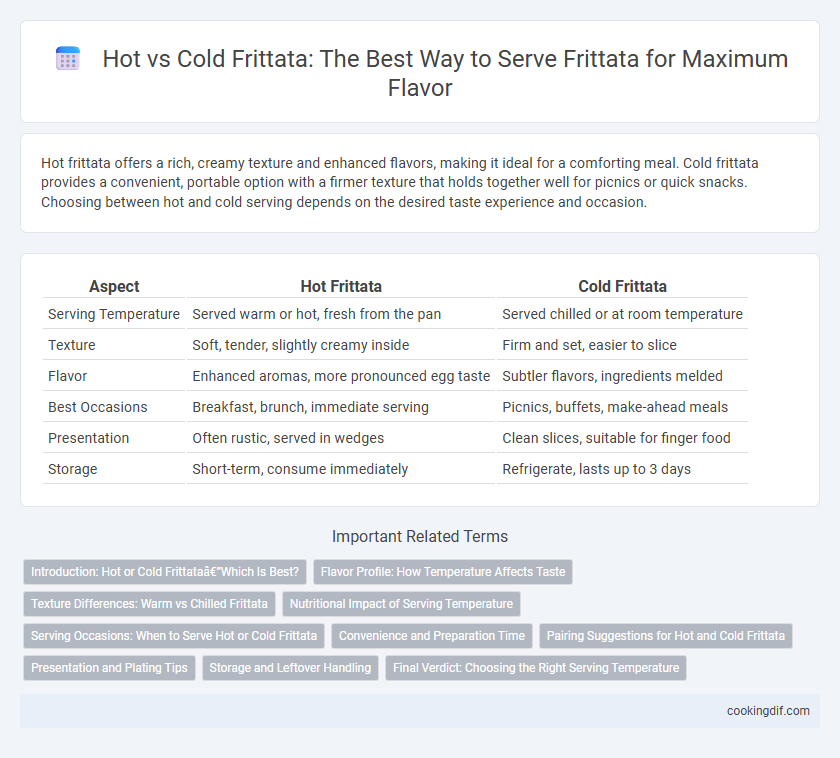Hot frittata offers a rich, creamy texture and enhanced flavors, making it ideal for a comforting meal. Cold frittata provides a convenient, portable option with a firmer texture that holds together well for picnics or quick snacks. Choosing between hot and cold serving depends on the desired taste experience and occasion.
Table of Comparison
| Aspect | Hot Frittata | Cold Frittata |
|---|---|---|
| Serving Temperature | Served warm or hot, fresh from the pan | Served chilled or at room temperature |
| Texture | Soft, tender, slightly creamy inside | Firm and set, easier to slice |
| Flavor | Enhanced aromas, more pronounced egg taste | Subtler flavors, ingredients melded |
| Best Occasions | Breakfast, brunch, immediate serving | Picnics, buffets, make-ahead meals |
| Presentation | Often rustic, served in wedges | Clean slices, suitable for finger food |
| Storage | Short-term, consume immediately | Refrigerate, lasts up to 3 days |
Introduction: Hot or Cold Frittata—Which Is Best?
Hot frittatas offer a creamy texture and enhanced flavors as the cheese melts and ingredients meld together, creating a satisfying warmth ideal for breakfast or brunch. Cold frittatas provide a convenient, protein-rich option that maintains its taste and structure, making it perfect for on-the-go meals or picnics. Both serve distinct culinary purposes, with hot frittatas emphasizing texture and aroma, while cold versions prioritize portability and ease.
Flavor Profile: How Temperature Affects Taste
Hot frittatas offer a richer, more pronounced flavor as warmth enhances the aroma and intensifies the savory notes of eggs, cheese, and vegetables. Cold frittatas tend to develop a milder taste, with flavors blending more subtly, making them ideal for delicate herbs and chilled accompaniments. Serving temperature significantly influences the texture and flavor release, with heat amplifying umami and cold emphasizing freshness and creaminess.
Texture Differences: Warm vs Chilled Frittata
Hot frittata features a soft, creamy texture with a slightly custardy interior that melts in the mouth, enhancing the flavors of fresh ingredients. In contrast, cold frittata firm ups, developing a denser and more compact consistency that makes it easier to slice and serve as finger food. The temperature significantly impacts the mouthfeel, with warmth emphasizing silkiness and chilling highlighting structural integrity.
Nutritional Impact of Serving Temperature
Hot frittatas retain more moisture, enhancing nutrient absorption, especially for fat-soluble vitamins like A, D, E, and K. Cold frittatas may undergo slight nutrient degradation due to refrigeration, but they provide a convenient, protein-rich option with preserved B-vitamins and minerals. Serving temperature influences bioavailability, with warmth aiding digestion and nutrient uptake compared to chilled servings.
Serving Occasions: When to Serve Hot or Cold Frittata
Hot frittata is ideal for breakfast or brunch gatherings where warm, freshly cooked dishes enhance the meal experience, offering a creamy texture and rich flavors that are best enjoyed immediately. Cold frittata suits picnics, potlucks, and quick lunches, as it maintains its structure and flavors even when chilled, allowing for easy transport and serving without reheating. Choosing between hot and cold frittata depends on the occasion's timing, convenience, and desired taste profile for optimal enjoyment.
Convenience and Preparation Time
Hot frittata offers a freshly cooked, warm meal ideal for immediate serving, with a preparation time of approximately 20-25 minutes. Cold frittata provides convenience for on-the-go eating or advance meal prep, allowing easy slicing and serving without reheating. Choosing between hot and cold frittata depends on the need for quick ready-to-eat options versus enjoying a freshly warmed dish.
Pairing Suggestions for Hot and Cold Frittata
Hot frittata pairs exceptionally well with fresh, crisp salads featuring arugula or mixed greens, enhancing its warm, savory flavors, while a glass of light white wine such as Pinot Grigio balances the richness. Cold frittata complements charcuterie boards and roasted vegetables, with a chilled rose or sparkling water providing a refreshing contrast. Both serving styles benefit from herb garnishes like basil or chives to elevate the overall taste experience.
Presentation and Plating Tips
Serving a hot frittata enhances its airy texture and vibrant colors, making it visually appealing when garnished with fresh herbs and a drizzle of olive oil. Cold frittata slices hold their shape well, ideal for neat plating on charcuterie boards or as part of a layered salad, complemented by crisp greens or roasted vegetables. For both, using a sharp knife ensures clean edges, and arranging garnishes with contrasting colors elevates the presentation, enticing guests with a visually balanced dish.
Storage and Leftover Handling
Hot frittata offers optimal taste and texture when served immediately, preserving its creamy interior and golden crust, while cold frittata requires proper refrigeration within two hours to avoid bacterial growth. Store leftovers in an airtight container in the refrigerator for up to 3-4 days, ensuring safe consumption and maintaining flavor. Reheating in a preheated oven or microwave with a cover helps retain moisture and prevents drying.
Final Verdict: Choosing the Right Serving Temperature
Serving a hot frittata enhances the flavors and textures, making the eggs fluffy and the ingredients more aromatic, which is ideal for immediate consumption. Cold frittata offers convenience for meal prep and portability, with flavors that intensify and meld over time, perfect for packed lunches or buffets. The final verdict depends on preference: choose hot for freshness and texture, or cold for convenience and enhanced flavor integration.
Hot Frittata vs Cold Frittata for serving Infographic

 cookingdif.com
cookingdif.com